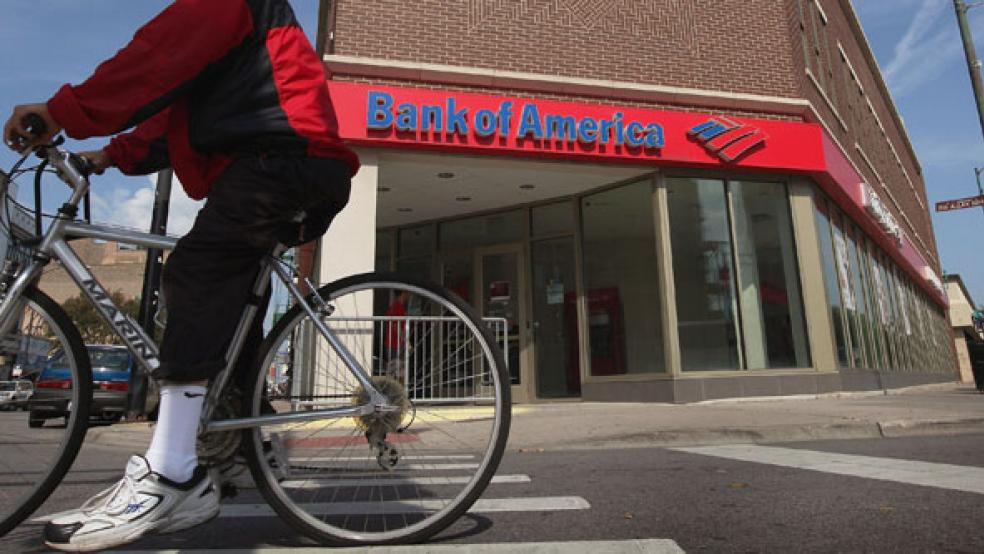Bank of America is ramping up foreclosures, pushing through paper on thousands of delinquencies that have been delayed because of the “robo-signing” scandal. A nationwide increase in foreclosures means more pain for consumers in the short term, but a better outlook for the economy in the long run. Experts say cleansing the bank’s books of bad debt is necessary in order for the battered housing market to recover.
In the last month alone, BofA issued nearly 10,000 notices of default (NOD) in California and Nevada, a 184 percent increase from the 3,500 NODs in July, according to Mark Hanson, President of Hanson Advisers, a housing and mortgage research firm. An NOD is the first step in the foreclosure process.
A Bank of America spokesperson said they are not at “full capacity in all 50 states yet,” but they are restarting the foreclosure process in states where foreclosures don’t go before a judge, which allows for a speedier process.
“We are seeing continued improvements in foreclosure volumes in many areas of the country, and that is a potential harbinger for housing market recovery,” BofA said in a statement. “Strong gains like that from July to August demonstrate our progress – primarily in non-judicial states like California and Nevada -- clearing more volume to advance to foreclosure once we pass the numerous, improved quality controls we have in place and only after all other options with homeowners have been exhausted. The industry has not yet returned to normal or necessary foreclosure activity levels, but progress is certainly being made.”
Bank of America manages nearly 20 percent of all mortgage loans in the country since its merger with Countrywide. BofA’s spike in activity immediately affected the national foreclosure numbers -- total of 228,098 foreclosures were filed in August, a seven percent increase from July, according to RealtyTrac. The jump in foreclosures may also foreshadow more bank repossessions in the coming months, said James Saccacio, chief executive officer of RealtyTrac. The total number of bank owned foreclosures is roughly 700,000.
It’s unclear if this is a one-month purge of backlogged paperwork or if other mortgage lenders will follow suit, but Hanson suspects BofA is “completely changing the way they do business because the old way isn’t working.” The troubled bank recently announced it would shed 30,000 employees and cut its annual costs by $5 billion by the end of 2013. They also announced a shakeup in its executive ranks, which split the bank into two separate units, one to serve consumer clients and one to serve commercial customers.
“The only way the banks are going to get healthy is to get rid of all this trash on their balance sheets,” Hanson said. “Right now they [banks] are holding back a dam. The reservoir has been filled to the brim with late stage defaults and pending foreclosures. The banks and government have all been metering them so not to destroy the market, but they’ve just delayed the pain.” If the market is flooded with more foreclosed homes, investors would buy them and turn them into rentals, Hanson said.
It’s nearly been one year since the foreclosure moratorium began, after it was discovered that thousands of robo-signers validated affidavits without reading them or having a notary present. These allegations forced banks nationwide to halt foreclosures while they conducted internal investigations for wrongly foreclosing on homeowners. Industry experts say the robo-signing of mortgages, though completely resolved, is under far greater scrutiny.
Until the inventory of nearly 5 million distressed homes—those already on the banks books, currently in foreclosure or seriously delinquent on payments—are processed a recovery can’t begin, said Rick Sharga, vice president of RealtyTrac. “In an odd way this is good,” he said.
Leslie Linfield, executive director for the Institute for Financial Literacy, added that the foreclosure moratorium added more lingering doubt in the housing market than it really helped consumers. “In order to see the light at the end of the tunnel we need to be able to process foreclosures,” she said. “If home owners can’t save their homes through bankruptcy, then they need to move forward with their lives and start over. That way the entire economy can move forward. We need to just accept that there are going to be people that are going to lose their home.”
In the short term, additional foreclosed homes will end up on an already crowded market at a discount causing home prices to decline further particularly if other servicers start doing the same thing, said Celia Chen, economist with Moody’s Analytics. “I think this is the beginning of a trend,” she said.
Since the financial crisis began in late 2007, U.S. housing prices have plunged more than 27 percent on average according to the S&P/Case Shiller Home Price Index. As home prices fall, so do home sales. The pace of sales for previously occupied homes is trailing last year's 4.91 million sold, the fewest since 1997, according to the National Association of Realtors. In a healthy economy, people buy approximately 6 million homes each year.
At the same time, Chen said the pickup in foreclosure activity isn’t a surprise. Moody’s expected the pace of foreclosures would quicken at the end of 2011 and home prices would decline. Chen forecasts home prices will drop another three percent over the next six to nine months and will bottom at the beginning of 2012. The worst impact on the housing market due to the increase of foreclosures will be felt in the next nine to 12 months, she said.
While there will be a negative impact to home prices, Hanson says it doesn’t matter much because property values are already down 50-60 percent from their peak in 2006, “so does it matter if they go down to 80 percent?” Homes will be more affordable for buyers, he said.
“It might be scary that Bank of America is cranking it out, but I hope they are,” Hanson said.





